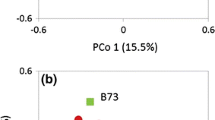Summary
Leaf chlorosis is one of the most obvious symptoms of low-temperature damage in maize. Divergent mass selection for chlorosis resistance was performed during two cycles of selection in two synthetic cold-tolerant populations. Both populations responded to selection, and after one cycle of selection the chlorosis resistant and susceptible selections already differed significantly. The two sets of corresponding C2 populations obtained were used for a growth analysis at 13/8, 15/10, 20/15°C (day/night) during the early phase of vegetative growth. All plants were chlorotic at 13/8°C, and only some at 15/10°C. Resistance to chlorosis increased the survival rate and the growth rate of the surviving plants at 15/10°C. Resistance, however, appeared to reduce the accumulation of shoot dryweight at 20/15°C. The correlated changes in morphology of the shoots due to selection for chlorosis resistance, such as thicker leaves, may in part have caused this undesirable effect. Despite the disadvantage, improvement of resistance is considered to have a positive effect on dry-matter yield and yield stability in areas with cool weather during vegetative growth.
Similar content being viewed by others
References
Alberda, T., 1969. The effect of low temperature on dry matter production, chlorophyll concentration and photosynthesis of maize of different ages. Acta Bot Neerl 18: 39–49.
CSRL (Commissie voor de Samenstelling van de Rassenlijst voor Landbouwgewassen), 1988. 63e Beschrijvende Rassenlijst voor Landbouwgewassen 1988. Leiter-Nypels, Maastricht, 335p.
Crèvecoeur, M. & J.-F. Ledent, 1984. Effets de basses températures (0–10°C) sur la croissance juvénile du mais: Quelques aspects de recherche fondamentale. Bulletin de la Société Royale de Botanique 117: 382–411.
Dolstra, O. & P. Miedema, 1986. Breeding for improved vegetative growth at low temperature in maize (Zea mays L.). In: Dolstra, O. & P. Miedema (Eds). Breeding of Silage Maize. Pudoc, Wageningen, pp. 61–70.
Gardner, C.O., 1969. The role of mass selection and mutagenic treatment in modern corn breeding. Report of the 24th Annual Corn and Sorghum Research Conference, ASTA, pp. 15–21.
Hodgins, R. & R.B. Huystee, 1985. Chilling-induced chlorosis in maize. Can J Bot 63: 711–715.
Hodgins, R. & R.B. Huystee, 1986. Delta-aminolevulinic acid metabolism in chill stressed maize (Zea mays L.). J Plant Physiol 126: 257–268.
McWilliam, J.R. & A.W. Naylor, 1967. Temperature and plant adaptation. I. Interaction of temperature and light in the synthesis of chlorophyll in corn. Plant Physiol 42: 1711–1715.
Miedema, P., 1982. The effect of low temperature on Zea mays. Adv Agron 35: 93–128.
Miedema, P., P. Groot & J. Post, 1987. The effects of low temperature on seedling growth of maize genotypes. Agricultural Research Reports 926. Pudoc, Wageningen.
Stamp, P., 1984. Chilling tolerance of young plants demonstrated on the exemple of mays (Zea mays L.). Advances in Agronomy and Crop Science. Supplement 7, 83 p.
Stamp, P., G. Geisler & R. Thiraporn, 1983. Adaptation to sub-and supraoptimal temperatures of maize lines differing in origin with regard to seedling development and photosynthetic traits. Physiol Plant 58: 62–68.
Author information
Authors and Affiliations
Rights and permissions
About this article
Cite this article
Dolstra, O., Jongmans, M.A. & de Jong, K. Improvement and significance of resistance to low-temperature damage in maize (Zea mays L.). I. Chlorosis resistance. Euphytica 39 (Suppl 3), 117–123 (1988). https://doi.org/10.1007/BF00043374
Received:
Accepted:
Issue Date:
DOI: https://doi.org/10.1007/BF00043374




